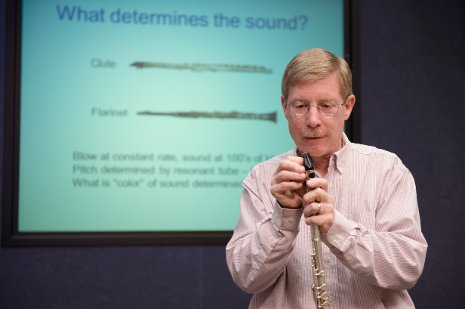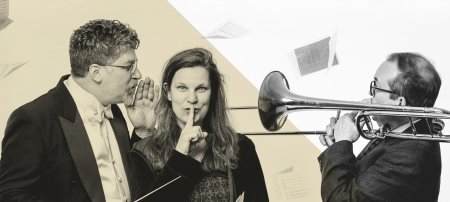Demonstrating Physics and a Passion for Teaching

Sports can be tough to understand. There are rules that govern what’s going on, but explaining them to someone unfamiliar with the game can be daunting.
Physics poses a similar problem. We experience the effects of physics every moment
of every day, but like the obscure rules of any sport, few of us understand the mechanics
of the physics all around us.
Bryan H. Suits, professor of physics at Tech, has found a more familiar way to explain
physics concepts to undergraduates who may have little background in the subject and
even less interest. He’s teaching “The Physics Behind Music.”
“There is a growing population of students at Tech who take only one physics class during their time here,” Suits said. “When I started my ‘Physics of Music’ class, their only options were to take astronomy, which remains a popular choice, or Mechanics I. I wanted to provide an option that gave a better overview of all of physics, at a level that I think every well-educated citizen should know. I have a personal interest in music, so using music as the motivator and underlying theme seemed quite natural to me.”
Suits uses a variety of examples taken from music to illustrate principles of physics for his classes. “I have a one-string electric guitar which I use to talk about simple vibrations, standing waves on a string, and, for the pick-up, Faraday's law of induction,” he says. Faraday’s law states that the induced electromotive force in any closed circuit is equal to the negative of the time rate of change of the magnetic flux through the circuit. For the novice, a practical explanation in familiar language can be a lifesaver.
In another example, Suits discusses the motion of waves specifically with respect to sound: “Reflection, diffraction and interference of waves is discussed in the context of sound waves and acoustics, with parallels made to the case of light. In the same vein, we can talk about data storage capabilities of disks -- such as blu-ray versus DVD. Why blue? It’s all related to these principles of waves.”
Gowtham (who uses only one name), senior academic consultant in Michigan Tech’s Information Technology department and himself PhD in physics, agrees on the need for the average citizen to understand physics. “There is a strong need for conveying classic physics ideas in terms everyone can understand,” he said, adding that “mathematical concepts can scare people away.”
There are many branches of physics, but classical mechanics remains the part of physics the average citizen can most readily comprehend and apply to everyday life, Gowtham suggests. “Think of everything from earthquakes to car accidents,” he said. “Or take the example of the Tacoma Narrows Bridge.”
This was a bridge that collapsed in 1940 due to resonance created by the wind. Films and images of its wildly pitching deck haves served as reminders to generations of physics and civil engineering students. “We deal with the principles of physics everyday.”
“We can understand classical mechanics most easily because it is observable,” Gowtham went on to say. “Think of cooking, for example, something that is time-dependent with certain initial conditions. I can understand the entire process very easily, and changing the inputs will result in predictable changes in output. If I use these ingredients in this order at this temperature, I will get this result.”
Suits concurs, but, he said, “for a physicist who goes through the usual physics training, the easiest way to teach physics is the way they learned it, as a physicist and with lots of math. It is much more difficult to try to find alternate ways to convey physics concepts to non-physicists, who make up the majority.”
And Suits’ efforts to use music to make physics accessible to non-physics majors is an important first step. “I am hoping others will be able to develop similar courses based around their own interests,” he said.
Physics Behind Music (PH1090) is offered online in the spring and summer semesters, and in the classroom each fall.
Michigan Technological University is an R1 public research university founded in 1885 in Houghton, and is home to nearly 7,500 students from more than 60 countries around the world. Consistently ranked among the best universities in the country for return on investment, Michigan's flagship technological university offers more than 185 undergraduate and graduate degree programs in science and technology, engineering, computing, forestry, business, health professions, humanities, mathematics, social sciences, and the arts. The rural campus is situated just miles from Lake Superior in Michigan's Upper Peninsula, offering year-round opportunities for outdoor adventure.




Comments